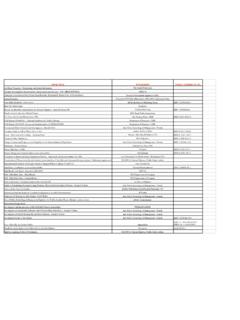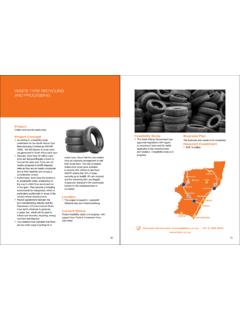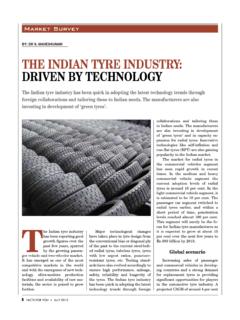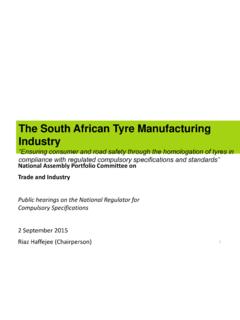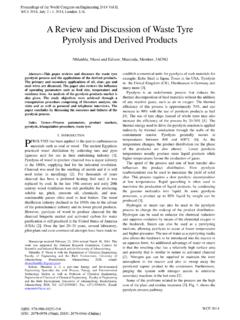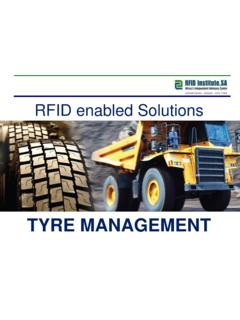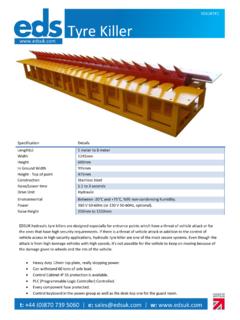Transcription of Tyre tread condition & insurance claims
1 Tyre tread condition & insurance claims : Countless queries have been raised on this topic and likewise numerous claims have been repudiated by the insurer and reversed by the insurance ombudsman, where the insured has had a valid case, has prompted a review. The combined issue of tyres , wheels, wheel alignment1 and vehicle handling in general, is an almost endless subject where much has been written in many reputable books, and online forums2. This article is not written to teach you all the finer details, however some issues are clarified. This article highlights the greater subject of the interrelated and far reaching effects that tyres in particular, however the inextricably linked issues, effect the decisions that are, or should be made on insurance claims .
2 Let`s firstly clarify a few specifics regarding tyres so that we are all at the same page as to what specific sections of tyre we are referring to. The images alongside are a simple representation of the wheel rim and tyre from the various views. Where reference is made to the rolling circumference of the tyre, this means the total outside rolling circumference of the tyre, where this is graphically indicated alongside by the red and green arrow. The tread breadth is that of the tread breadth that would normally make contact with the road surface, this breadth is graphically indicated with the red arrow in the image alongside.
3 The circumference measurement of the tyre is unambiguous but breadth of the tread must be addressed as some grey-area is apparent. The issue of tread breadth as reference in the National Road Traffic ACT (NRTA) has been addressed and largely clarified in the judgement of Swanepoel v Auto & General insurance Company Limited 2007 JDR 0004 (T), wherein the following notes are made: The word "breadth" used in Regulation 212(j)(i) does not mean the normal "breadth" of a tyre; The word "breadth" means the areas of continuous contact between a tyre and the road; The contact area which is relevant as far as the word "breadth" is concerned is the area where the tyre is in continuous contact with the road whilst travelling in its normal track.
4 It is therefore important to note that if the issue of the tread breadth is to be considered, and it usually is, such as where the one side of the tread is well worn and contact patch breadth specifications of the particular tyre are called into question. On such occasions, all efforts must be made to obtain clarity by means of the comparative analysis of a brand new tyre of the exact same specification where accurate measurements are obtained from both specimens and that where possible the contact patch measurements be obtained from the manufacturer and or by analysis of the exemplar tyre on an exemplar vehicle.
5 Despite this, the breadth of the contact patch of the tread can vary a few millimetres due to various factors, some of which are load and tyre pressure. Tyre tread in general is one of those subjects that inevitably raises discussion and wide varying opinions, and is to some extent seen as a grey area , in fact, this is far from correct. It is a simple case of obeying the set parameters laid down by a combination of the National Road Traffic act and that of the manufacturer s specification, if you do this correctly, you will not fall foul of the law and you re insurance . Let`s deal with the issue chronologically and start with just what the law says.
6 The specific act is NRTA 1996 Reg. 1999 Chapter VI, Part II (212), the following are the relevant items paraphrased: (d) a vehicle which is equipped with a metal tyre unless the whole width of the tread of the tyre is at all times in direct contact with the surface of the road; (e) a vehicle which is equipped with a tyre which is in such a state of disrepair or in such a condition that it may cause or is likely to cause damage to the road surface or may be or is likely to be a danger; (f) a motor vehicle which is equipped with a pneumatic tyre of which the rubber covering is so worn or damaged that the fabric or cord used in the construction of such tyre is exposed; (Ji) which is fitted with a pneumatic tyre unless such tyre displays throughout, across its breadth and around its entire circumference, a pattern which is clearly visible, and has a tread of at least one millimetre in depth.
7 Or 1 A general term covering the main alignment issues of Caster, Camber and Toe-in-Out and other factors 2 See some of the references supplied (Jii) which is fitted with a pneumatic tyre which contains a tyre tread depth indicator, if the tread is level with the tyre tread depth indicator (l) a motor vehicle which is equipped with a pneumatic tyre which has a break in its fabric or which has a cut, measured in any direction on the outside of the tyre and of such depth that it reaches the cords used in the construction of such tyre, in excess of 25 millimetres or 10 per cent of the maximum width of the tyre, whichever is the greater; or (m) a motor vehicle which is equipped with a pneumatic tyre which has a lump or bulge caused by the separation of or a partial break in its structure.
8 So what does this all mean in simple layman`s terms? Simply that at any given stage, the tyres of your vehicle must be in good condition , and cannot be at any level of disrepair worse than that set out by the law. Reference is often made to the 1mm minimum limit of tread depth, if we read Ji this minimum indication is clearly stipulated, and goes one step further to clarify that not only do we require a minimum of 1mm, but also that this must be a 1mm depth around its full circumference and across the tread breadth, as has been clarified above. Note also that at Jii , that specific reference is made to the use of the manufacturers tread depth indicator, this therefore indicates that the manufacturer s specification, by means of the indicator, takes precedent over the original 1mm indication as this is the specific design parameter of that tyre.
9 However that the circumferential and across the tread breadth specification still apply. The images alongside show typical tread depth indicators on the tyre, and how tread depth is measured. Jii also indicates that tyre tread levels may not be level with the tread depth indicator, the tread depth must be in-excess of this minimum level. Let`s look at a few common examples. The images below show typical tyre wear to the outer and inner shoulders of the tyre. This wear is most commonly the result of incorrect wheel alignment settings, typically created where prolonged use has seen critical component wear result in improper alignment, or where impacts have caused alignment to be out.
10 One of the more common tyre tread wear patterns that are seen, especially on modern high performance vehicles, is excessive wear of the inner shoulder as is visible in the image below. Let`s clarify why tyres need tread and why there is the 1 millimetre limit. In racing situations, slick tyres give the most grip, however we also see that in race situations grooved tyres are sometimes used. These grooves ( tread patterns) are specifically designed, among other factors, to disperse water from the path of the tyre, this dispersal of water can be seen in the high speed underside image below. If a tyre can no long disperse the water, the tyre begins to hydroplane as can be seen in the images below.
